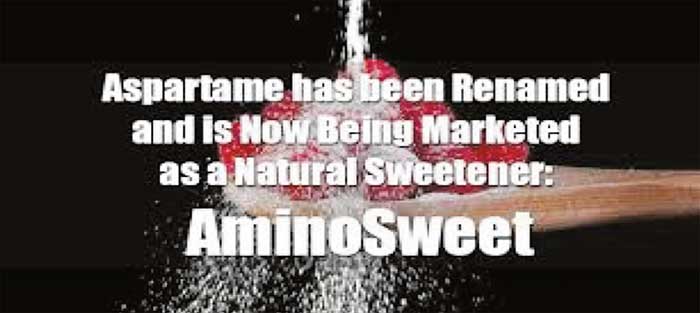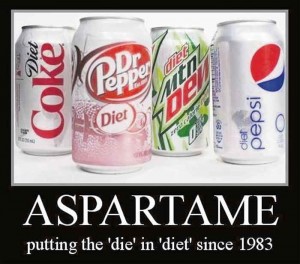Health conscious individuals are usually very particular about their diet and what they prefer to eat and drink. Low fat or sugar free food and drink is the order of the day. Likewise, those who have difficulty controlling their weight and waistline also opt for “slimline” foodstuffs and “diet” drinks in an attempt to rein in blubbery bellies and bulging bums. Those that prefer a good old fashioned cuppa instead of soda will most likely dump the sugar in favour of artificial sweeteners, in an endeavour to lose a few pounds and keep their weight in check.
If you are one of the many thousands of people that prefer to drink ‘diet’ or “light” soda over their sugar filled counterparts, or pop sweeteners into your cuppa instead of the real deal, then unfortunately for you, you are slowly but surely killing yourself.
Most diet, or sugar free drinks (and most types of sugar free sweeteners) available today contain a chemical sweetener called aspartame.
Aspartame is the technical term for the brand names NutraSweet, Equal, Spoonful, and Equal-Measure. It was discovered by accident in 1965 when James Schlatter, a chemist of G.D. Searle Company, was testing an anti-ulcer drug. The chemical was found to be 180 times sweeter than sugar yet contained no calories.
This chemical is currently on the ingredient list of nearly 6,000 various products worldwide. But since it was approved for use as a food additive in 1981, it has been dogged by complaints about its safety.
A short while after its discovery, in the autumn of 1967, a biochemist, Dr. Harold Waisman, conducted aspartame safety tests on infant monkeys on behalf of the products discoverers. Of the seven monkeys that were being fed aspartame mixed with milk, one died and five others had grand mal seizures.
During further testing in the spring of 1971 Neuroscientist Dr. John Olney informed Searle that his studies showed aspartic acid (one of the main ingredients of aspartame) caused holes in the brains of infant mice. One of Searle’s own researchers confirmed Dr. Olney’s findings in a similar study.
Despite the growing scientific evidence of aspartames dangerous toxicity, on July 26, 1974 the FDA granted aspartame its first approval for restricted use in dry foods.
However, amid growing concerns about the products safety, and following an FDA investigation of the laboratory practices of aspartame’s manufacturer, G.D. Searle, the approval was quickly revoked and aspartame was banned for public consumption. The investigation found Searle’s testing procedures shoddy, full of inaccuracies with “manipulated” test data. The investigators reported they “had never seen anything as bad as Searle’s testing.”
The 1980 FDA ban of aspartame followed 3 independent scientific studies of the artificial sweetener. They all concluded that regular aspartame intake resulted in a high probability of inducing brain tumours. One of the studies, conducted in 1977, discovered that of 196 animals used by Searle for testing aspartame, 98 died. A mass, a uterine polyp, and ovarian neoplasms were found in animals but not reported or diagnosed in Searle’s reports.
Unfortunately that wasn’t to be the end of the matter. There was a lot of money invested in this lethal toxin, and no amount of scientific scrutiny was going to hamper its approval and subsequent release upon an unsuspecting public.
In January of 1981 Donald Rumsfeld, (the same Rumsfeld who later became defence secretary to George Bush and propagated the killing fields of Iraq and Afghanistan), then CEO of Searle, stated in a sales meeting that he was going to “call in his markers” and make a push to get aspartame approved. That month Ronald Reagan was sworn in as President of the United States. His transition team included Rumsfeld who hand picked Dr. Arthur Hull Hayes Jr. to be the new FDA Commissioner.
Within a couple of months, Hayes appointed a 5-person Scientific Commission to review the claims on aspartame. In a 3 – 2 decision, the panel upheld the original ban, stating that the artificial sweetener was unsafe.
Despite the panel’s decision, which endorsed the previous ban of aspartame, Hayes still had an agenda to fulfil. Not to be outdone he proceeded to install a sixth member on the commission who was instructed to vote in favour of making aspartame legal. The vote was now deadlocked.
Hayes personally broke the tie in aspartame’s favour and Aspartame was finally given FDA approval for use in dry goods in July 1981, despite objections from three of six in-house FDA scientists who were responsible for reviewing the brain tumour issues.
In September 1983 Hayes left his post at the FDA amid scandal and accusations that he was accepting corporate gifts for political favours. BUT, just before leaving office Hayes approved the use of aspartame in beverages, despite the fact that just a couple of months previous the National Soft Drink Association (NSDA) urged the FDA to delay approval of aspartame for carbonated beverages pending further testing because aspartame is very unstable in liquid form. When liquid aspartame is stored in temperatures above 85 degrees Fahrenheit, it breaks down into DKP and formaldehyde, both of which are known noxious neurotoxins.
Diet sodas containing this deadly additive were on supermarket shelves within a few weeks, and have sold in their billions ever since.
So what really is so bad about aspartame. Surely if a product has been approved for human consumption it should be safe to eat or drink, shouldn’t it?
The answer to that question lies in ones ability to comprehend that corporate interests far outweigh personal safety. One only has to evaluate the available evidence to realise that the perpetual profiteering of huge corporations is far more imperative to them than the health of the consumer. When one also considers that aspartame is produced by a pharmaceutical company, Pfizer, it shouldn’t be too difficult to realise what a perfect business model they have. They screw up the health of the unwitting customer with aspartame, then sell them a remedy for their ailment. It’s a win win situation and they’re laughing all the way to the bank.
So how bad is it?
Consider that aspartame accounts for over 75 percent of all reports to the FDA [Food & Drug Administration] relating to adverse reactions to food additives. Many of these reactions are extremely serious, including seizures and death.
A few of the 90 different documented symptoms listed in the report as being caused by aspartame include: Headaches, migraines, dizziness, seizures, nausea, numbness, muscle spasms, weight gain, rashes, depression, fatigue, irritability, tachycardia, insomnia, vision problems, hearing loss, heart palpitations, breathing difficulties, anxiety attacks, slurred speech, loss of taste, tinnitus, vertigo, memory loss, and joint pain. If any readers suffer from any of these symptoms they might want to reflect on what they’ve had to drink recently.
Furthermore, according to researchers and physicians studying the adverse effects of aspartame, the following chronic illnesses can be triggered or worsened by ingestion of this toxic chemical:
- Brain tumours,
- Multiple sclerosis,
- Epilepsy,
- Chronic fatigue syndrome,
- Parkinson’s disease,
- Alzheimer’s,
- Mental retardation,
- Lymphoma,
- Birth defects,
- Fibromyalgia
It is particularly hazardous to foetuses and infants.
According to Dr. Russell Blaylock, a retired neurosurgeon who has written three books about the health dangers of excitotoxins (which includes aspartame), Dr. Adrian Gross, the FDA’s toxicologist who examined the aspartame research initially presented to the FDA for approval by G.D. Searle, was “absolutely shocked” at the evidence showing an enormous increase in tumours, particularly brain tumours, associated with the intake of aspartame.
More recently, a study published in 2010 found that aspartame induced cancers of the liver and lung in male mice. It was also carcinogenic in male and female rats. Another study of great importance was published just last year. It’s the most comprehensive and longest human study ever conducted, spanning 22 years, that has ever investigated aspartame toxicity. The study evaluated the relationship between aspartame intake and cancer, and found a clear association between aspartame consumption and non-Hodgkin’s Lymphoma and leukaemia.
To date over 900 different independent studies have been conducted regarding the adverse side effects of aspartame intake. Every single one of them corroborated its damaging effects.
But here’s the kicker…..
The majority of diet soda drinkers or artificial sweetener users do so in the belief that it will help reduce that burgeoning waistline, or help control debilitating diabetes. There is a misguided conviction that substituting sugar intake with a calorie free alternative will help with weight loss and slimming, or assist with insulin sensitivity. However, numerous studies have confirmed that the use of sugar substitutes actually has the opposite effect.
Despite being promoted for weight loss, foods and beverages with artificial sweeteners have never been proven to help weight loss. In fact research into this actually found artificial sweeteners promote weight gain. Research has also shown that diet sodas may actually double your risk of obesity.
Likewise, studies have also demonstrated that aspartame worsens insulin sensitivity to a greater degree than sugar, posing a hidden health threat to diabetics who follow the recommendation to switch to diet sodas to manage their condition.
Aspartame has been shown to stimulate appetite, increase carbohydrate cravings, and promote fat storage. It activates your appetite but leaves you with less calories, and in turn your body craves even more. People who drink diet soda are more likely to become overweight or obese – that is undeniable fact.
I cringe when I see uninformed parents giving “diet” drinks to their young children. The debilitating effects of aspartame are particularly lethal to youngsters as their brains and organs are still developing, and are much more susceptible to the damaging effects of methanol and formaldehyde, both of which are extremely toxic, and both of which are present in various forms in aspartame. Formaldehyde is a known carcinogen that causes retinal damage, interferes with DNA replication and may cause birth defects.
Additionally, one of the effects of constant ingestion of aspartame is excessive build up of phenylalanine in the brain, which in turn can cause schizophrenia or make one more susceptible to seizures.
Whilst I can’t demand everyone stops consuming this extremely toxic substance, what I can do is urge each and every one of you to research this extremely questionable additive before you add that next diet coke or slimline tonic to your vodka or gin, or before you add that artificial sweetener to your cuppa or cereals. There is an abundance of information available on the Internet. I typed “aspartame dangers” into Google and got 332,000 results.
Just in case the above has not deterred some from taking this lethal substance they may want to consider how aspartame is produced.
According to the patent for aspartame:
“The artificial sweetener aspartame, a dipeptide with the formula Asp-Phe-me, is produced using a cloned micrcorganism [sic]. A DNA which codes for a large stable peptide comprised of the repeating amino acid sequence (Asp-Phe)n is inserted into a cloning vehicle which in turn is introduced into a suitable host microorganism. The host microorganism is cultured and the large peptide containing the repeating Asp-Phe sequence is harvested therefrom. The free carboxyl group of the large peptide is benzylated and then hydrolysed to benzyl Asp-Phe dipeptides. This dipeptide is methylated and then debenzylated to form aspartame.”
This scientific gobbledygook obfuscates (perhaps deliberately) a truly disturbing process:
What the above is actually stating is that genetically modified E-coli bacteria are cultivated in large tanks that are designed to make them thrive. The well-fed E-coli cultures defecate the proteins that contain the aspartic acid-phenylalanine amino acid segment needed to make aspartame.
Or in really plain English:
Aspartame is made from the shit of genetically modified E-coli bacteria…….
Still fancy that diet coke?








